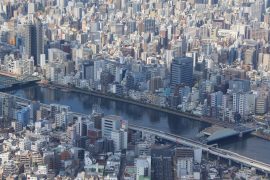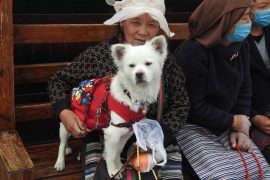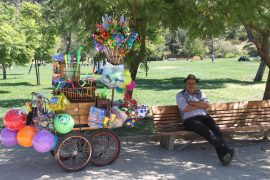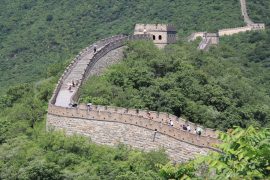 IT IS very early, the sun just a pale yellow glow peeping from behind the glowering purple mountains, but already several of the distinctive foot-rowing fishermen are paddling their narrow open flatboats across the liquid-silver water of Inle Lake in Myanmar’s Shan province.
IT IS very early, the sun just a pale yellow glow peeping from behind the glowering purple mountains, but already several of the distinctive foot-rowing fishermen are paddling their narrow open flatboats across the liquid-silver water of Inle Lake in Myanmar’s Shan province.
Once in their chosen spot they begin the agile dance-like process of casting their enormous semi-rigid cone nets while using their feet to keep the canoe in place.
Occasionally they beat on the top of the lake with their oar to chase the fish from the dense clumps of water hyacinth towards their nets.
It’s a scene that has changed little in centuries although today the fishermen find themselves battling with the wake of the larger, noisier, motorised longboats that transport locals, move bulk goods and exhilarate tourists.  Life here exists entirely on, and from, the beautiful expansive freshwater lake, the second largest in Myanmar. There are whole villages on stilts, houses ranging from small, rather ramshackle bamboo affairs to large double-storey timber structures. Large restaurants and artisans’ workshops are alongside family homes.
Life here exists entirely on, and from, the beautiful expansive freshwater lake, the second largest in Myanmar. There are whole villages on stilts, houses ranging from small, rather ramshackle bamboo affairs to large double-storey timber structures. Large restaurants and artisans’ workshops are alongside family homes.
The lake is the means of transport, communication, washing and other household amenities, and food production and transportation. Huge floating beds of tomatoes ripen in the brilliant sunshine.
 A large colourful market rotates daily between five different lakeside sites and draws the lake dwellers as well as a diverse mix of ethnic groups from the nearby hills and plateaus.
A large colourful market rotates daily between five different lakeside sites and draws the lake dwellers as well as a diverse mix of ethnic groups from the nearby hills and plateaus.
Bagan in Myanmar’s centre is seen by many as the jewel in its crown, home to one of the largest, most breathtaking collections of Buddhist stupas, pagodas and temples in the world, many dating back to the 11th century.
The sheer scope of the structures, a unique memorial to an ancient royal city, takes your breath away, their curves and spires puncturing the horizon. Though some are hardly taller than a human, others are huge ornate edifices that still function as working temples.
It’s impossible to visit them all (numbers seem to vary between 2000 and 3000) but it is worth taking the time to explore some of the larger ones, such as the Tharabar Gate with its tragic tale of lost love and Gubyaukgyi with its magnificent and well-preserved drawings.
 Centuries of earthquake damage and haphazard restoration work have tarnished the area’s architectural integrity but, to the amateur visitor, the damaged stupas seem to add to the slightly surreal feel of the landscape.
Centuries of earthquake damage and haphazard restoration work have tarnished the area’s architectural integrity but, to the amateur visitor, the damaged stupas seem to add to the slightly surreal feel of the landscape.
Just 45km from old Bagan is Mt Popa, famous for its shrine dedicated to animist spirits. The highlight though is Mt Popa Temple, reached via a covered stairway of about 800 steps that is home to a cheeky, occasionally thieving band of monkeys. The effort is rewarded with spectacular views.
Myanmar’s major city is Yangon (formerly Rangoon). Technically it’s no longer the capital the generals ordered in 2005 it should be moved to Nay Pyi Taw about 320km north in the country’s centre. But Yangon remains the business and diplomatic heart of the country.
 Many parts are delightful, with wide tree-lined boulevards lined with huge colonial houses half hidden behind high, ornate walls. Green and lush with a number of large parks, it hasn’t yet been overwhelmed by high-rise buildings, although it is experiencing a huge growth spurt.
Many parts are delightful, with wide tree-lined boulevards lined with huge colonial houses half hidden behind high, ornate walls. Green and lush with a number of large parks, it hasn’t yet been overwhelmed by high-rise buildings, although it is experiencing a huge growth spurt.
Downtown, the golden domed Sula Paya, a working temple, provides what must be the world’s most impressive roundabout. Not far away there are some of the finest examples of colonial-style buildings such as the former Secretariat Buildings, the one-time seat of government, the historic Strand Hotel, the Myanmar Port Authority and the High Court. There appears to be a concerted effort to preserve the colonial heritage, although many fear the financial rewards of Myanmar’s rapid commercial expansion will be too much of a temptation to save them all.
It’s worth doing some exploring on foot as you can see into many of the walled enclaves, some now diplomatic enclaves. The National Museum is an unprepossessing building but inside it’s full of treasures and you may well bump into a local only too happy to be your unofficial guide.
 Yangon’s biggest drawcard is the awesome Shwedagon Pagoda where holy relics of the Buddha were said to be enshrined 2500 years ago. The golden domes rising more than 100m can be seen shimmering in the sunshine from most parts of the city, or glowing a dramatic orange and red in the sunset.
Yangon’s biggest drawcard is the awesome Shwedagon Pagoda where holy relics of the Buddha were said to be enshrined 2500 years ago. The golden domes rising more than 100m can be seen shimmering in the sunshine from most parts of the city, or glowing a dramatic orange and red in the sunset.
There are lifts at two of the entrances, but much more pleasant and atmospheric is to make the gentle climb up the eastern stairway past the monasteries.
Just the name Mandalay (about 675km north of Yangon) conjures up images of old-world Asian elegance and charm. First impressions of Mandalay today are a bit of a shock ugly buildings, choked roads and a bustling commercial centre. But you don’t have to go far to find the cultural and aesthetic heart. Mandalay Hill, which dominates the horizon, once housed a large royal city and now rewards visitors who climb to the top with spectacular views.
Very close is the Kuthodaw Paya,  said to house the largest book of Buddhist scriptures, and Mandalay Palace, a replica of the sprawling royal city and now lying slap in the middle of a major military compound. Foreigners are allowed in but it’s strictly eyes forward only and no pictures of anything soldier-like.
said to house the largest book of Buddhist scriptures, and Mandalay Palace, a replica of the sprawling royal city and now lying slap in the middle of a major military compound. Foreigners are allowed in but it’s strictly eyes forward only and no pictures of anything soldier-like.
About 90 minutes’ drive away is the hill station of Maymyo, where the architecture and streetscapes are virtually the same as when the families of the colonial rulers came to escape the fierce heat of summer. It has a wonderful sprawling indoor-outdoor market and you can explore the area in horse-drawn carriages.
Myanmar has been officially shunned by most Western countries for decades since the takeover by a brutal military dictatorship and ongoing human rights abuses.
But today many locals are optimistic that the moves towards democracy, in particular the rise of the party led by national hero Aung San Suu Kyi, marks the beginning of a brighter future.
Sadly, despite all its natural wealth, most people still live in poverty, with much of the rich resources, such as the huge teak forests, already looted by the families of the ruling cadre.
Stunningly beautiful with a diverse and fascinating history, Myanmar holds enormous promise for locals and visitors alike. The people, big city and the most remote rural community, are universally welcoming.
As Suu Kyi said on her recent international tour, the key is to make sure everyone in the country shares in the benefits from the expected rapid change.





1 Comment
Beautifully written , very evocative and enticing. I have a lovely picture of your experience. Heather